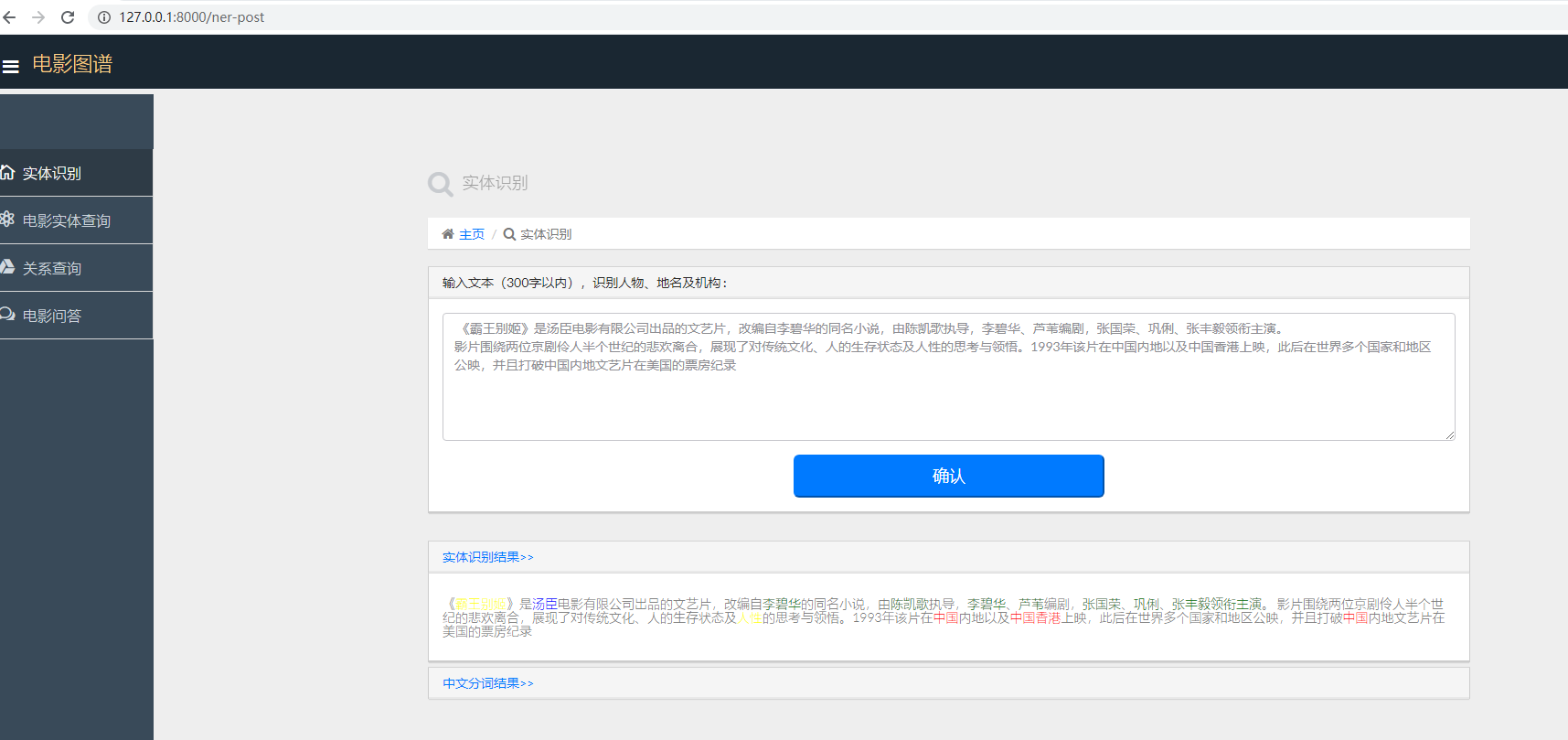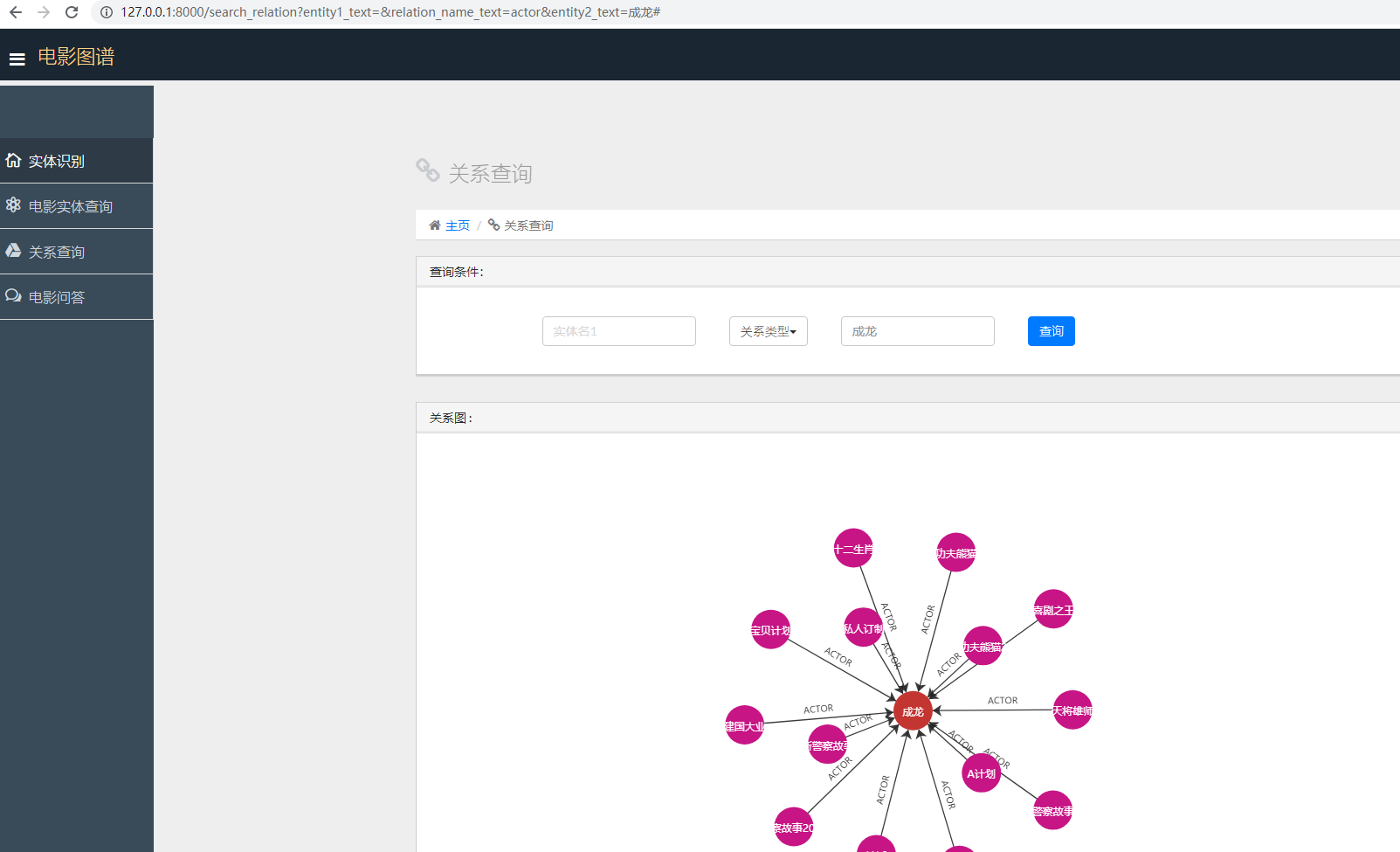功能主要包括实体识别、实体查询、关系查询以及问答几个模块。
项目中用到的数据来自网上公开数据集
前端页面参考:https://github.com/qq547276542/Agriculture_KnowledgeGraph,在此表示非常感谢。
note:以下数据导入是在Neo4j控制台上完成,将数据data/node与data/relation放入neo4j安装目录下import文件夹下:
三类实体(节点):
实体类型 数据文件 数量 说明
Movie Movie.csv 4587 电影实体
Person Person.csv 22937 人员实体
Country Country.csv 84 国家实体
四类关系:
关系类型 主语实体类型 宾语实体类型 数据文件 数量 说明
ACTOR Movie Person actor.csv 35257 电影的主演
COMPOSER Movie Person composer.csv 8345 电影的编剧
DIRECTOR Movie Person director.csv 5015 电影的导演
DISTRICT Movie Country district.csv 6227 电影的制片国家/地区
1.create constraint on (c:Country) assert c.id is unique
2.create constraint on (m:Movie) assert m.id is unique
3.create constraint on (p:Person) assert p.id is unique
1.create index on :Country(name)
2.create index on :Movie(name)
3.create index on :Person(name)
1.Country节点
call apoc.periodic.iterate(
'call apoc.load.csv("node/Country.csv",{header:true,sep:",",ignore:["label"]}) yield map as row return row',
'create(p:Country) set p=row',
{batchSize:1000,iterateList:true, parallel:true})
2.Movie节点
call apoc.periodic.iterate(
'call apoc.load.csv("node/Movie.csv",{header:true,sep:",",ignore:["label"]}) yield map as row return row',
'create(p:Movie) set p=row',
{batchSize:1000,iterateList:true, parallel:true})
3.Person节点
call apoc.periodic.iterate(
'call apoc.load.csv("node/Person.csv",{header:true,sep:",",ignore:["label"]}) yield map as row return row',
'create(p:Person) set p=row',
{batchSize:1000,iterateList:true, parallel:true})
1.关系:Movie-[:ACTOR]->Person
call apoc.periodic.iterate(
'call apoc.load.csv( "relation/actor.csv",{header:true,sep:","}) yield map as row match (start:Movie{id:row.start_id}), (end:Person{id:row.end_id}) return start,end',
'create (start)-[:ACTOR]->(end)',
{batchSize:1000,iterateList:true, parallel:false})
2.关系:Movie-[:COMPOSER]->Person
call apoc.periodic.iterate(
'call apoc.load.csv( "relation/composer.csv",{header:true,sep:","}) yield map as row match (start:Movie{id:row.start_id}), (end:Person{id:row.end_id}) return start,end',
'create (start)-[:COMPOSER]->(end)',
{batchSize:1000,iterateList:true, parallel:false})
3.关系:Movie-[:DIRECTOR]->Person
call apoc.periodic.iterate(
'call apoc.load.csv( "relation/director.csv",{header:true,sep:","}) yield map as row match (start:Movie{id:row.start_id}), (end:Person{id:row.end_id}) return start,end',
'create (start)-[:DIRECTOR]->(end)',
{batchSize:1000,iterateList:true, parallel:false})
4.关系:Movie-[:DISTRICT]->Country
call apoc.periodic.iterate(
'call apoc.load.csv( "relation/district.csv",{header:true,sep:","}) yield map as row match (start:Movie{id:row.start_id}), (end:Country{id:row.end_id}) return start,end',
'create (start)-[:DISTRICT]->(end)',
{batchSize:1000,iterateList:true, parallel:false})
1.下载hanlp模型和hanlp的jar包放在目录Anaconda3\Lib\site-packages\pyhanlp\static
2.在路径Anaconda3\Lib\site-packages\pyhanlp\static\data\dictionary\custom下放以下文件(data/custom_dict/演员名.txt,data/custom_dict/电影名.txt,data/custom_dict/电影类型.txt,data/custom_dict/other.txt),当自定义词典
演员名.txt
电影名.txt
电影类型.txt
other.txt
3.修改自定义词典配制D:\Anaconda3\Lib\site-packages\pyhanlp\static\hanlp.properties
CustomDictionaryPath=data/dictionary/custom/CustomDictionary.txt; 现代汉语补充词库.txt; 全国地名大全.txt ns; 人名词典.txt; 机构名词典.txt; 上海地名.txt ns; 电影类型.txt ng; 电影名.txt nm; 演员名.txt nnt; other.txt;data/dictionary/person/nrf.txt nrf;
.
├── data
│ ── custom_dict // 常规数据
│ ── node // 电影node数据
│ ── relation // 电影relation数据
│
├── intent_classification
│ ── classification_data //意图识别训练数据
│ ── pytorch // 神经网络分类模型
│ ── scikit_learn // 传统机器学习模型
│
├── movie_kg // django项目路径
│ ├── Model // 模型层,用于和neo4j交互,实现查询等核心功能
│ ├── movie_kg // 用于写页面的逻辑(View)
│ ├── static // 静态资源
│ ├── templates // html页面
│ └── util // 包括预加载一些数据和模型
.
本地启动命令:python manage.py runserver (或 movie_kg\run.bat)
主要识别人物、地名、机构、电影名以及明星名
输入电影名或演员名会图谱化展示直接关系
4种主要实体关系:actor、composer、director、district
可以选择不同的关系类型,输入电影名或演员名,给个图谱展示
1.利用分类模型对用户输入的问题进行意图识别
(1).训练数据在目录 intent_classification\classification_data\classification_segment_data.txt
(2).总共16个意图类别,见目录 intent_classification\classification_data\question_classification.txt
(3).意图识别
a.分类模型1,这里使用feedforward-network进行意图识别
训练代码:intent_classification\pytorch\feedforward_network\train.ipynb
预测代码:intent_classification\pytorch\feedforward_network\predict.ipynb
b.分类模型2,这里使用textcnn进行意图识别
其中[sgns.sogou.char]使用了sogou的预训练向量可从这里下载(https://github.com/Embedding/Chinese-Word-Vectors)
训练代码:intent_classification\pytorch\textcnn\train.ipynb
预测代码:intent_classification\pytorch\textcnn\predict.ipynb
c.分类模型3,这里使用textrnn进行意图识别
其中[sgns.sogou.char]使用了sogou的预训练向量可从这里下载(https://github.com/Embedding/Chinese-Word-Vectors)
训练代码:intent_classification\pytorch\textrnn\train.ipynb
预测代码:intent_classification\pytorch\textrnn\predict.ipynb
d.分类模型4,这里使用textrcnn进行意图识别
其中[sgns.sogou.char]使用了sogou的预训练向量可从这里下载(https://github.com/Embedding/Chinese-Word-Vectors)
训练代码:intent_classification\pytorch\textrcnn\train.ipynb
预测代码:intent_classification\pytorch\textrcnn\predict.ipynb
2.意图识别后,有一个slot filling(即槽填充),这里采用词典形式进行槽填充(即将电影名,演员名等加入pyhanlp的词典中),利用pyhanlp进行实体识别(槽填充)。
3.将识别的意图以及提取的槽位(即识别的实体)转为cypher语言,在neo4j中进行查询得到答案
利用分类模型预测用户提问的意图类别,将不同的意图类别转换为不同的cypher语言,从neo4j中查询得到答案。
1.利用pytorch的深度模型做实体识别
2.增加更多训练数据,尝试利用其它深度模型作意图识别,如textcnn,bert等
3.增加一个页面,给一篇关于电影的新闻,利用深度模型自动抽取实体和关系,并图谱化展示
4.增加多轮对话功能
5.增加闲聊功能
...
requirement.txt
- https://github.com/jiangnanboy/movie_kg
- https://github.com/qq547276542/Agriculture_KnowledgeGraph
- https://github.com/jiangnanboy/chatbot
如有搜索、推荐、nlp以及大数据挖掘等问题或合作,可联系我:
1、我的github项目介绍:https://github.com/jiangnanboy
2、我的博客园技术博客:https://www.cnblogs.com/little-horse/
3、我的QQ号:2229029156



